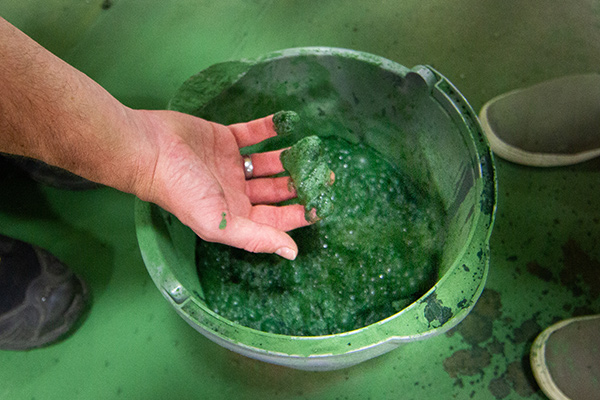
Dense algae blooms can choke our waterways and pose a threat to life of various species on our planet, and yet also represent a large, untapped renewable resource. Therein lies the motivation a decade ago behind the creation of clean-technology company Algix LLC. The company uses algae to help clean the environment, and to create a thermoplastic foam material to displace plastics such as ethyl vinyl acetate (EVA) in consumer products such as footwear.
Biotech scientist Ryan Hunt and engineer Mike Van Drunen co-founded the firm in 2010 to conduct research on aquatic biomass such as algae, with the aim of developing sustainable solutions for bio-based plastics and biocomposites.
After starting the company, Hunt, Van Drunen and their team spent four years developing and refining the extrusion process, as well as developing a harvesting and drying technology, with the aim of creating a commercially viable operation. Algix connected with governments, universities and private companies that were researching algae biotechnology, building a network of algae suppliers.
In a recent phone interview, Hunt, the firm’s chief technology officer, explained that they harvest and squeeze the wet algae into a paste, making it ready for drying. Using heat, they dry the algae paste to produce crunchy flakes. They then smash together those protein-rich algae flakes to create a fine green powder that they blend into thermoplastic compounds that carry the Bloom® trade name. Algix blends the algae powder with polymers to produce Bloom pellets that are ready to be made into high-performance foam products.
Turning sludge into cool products
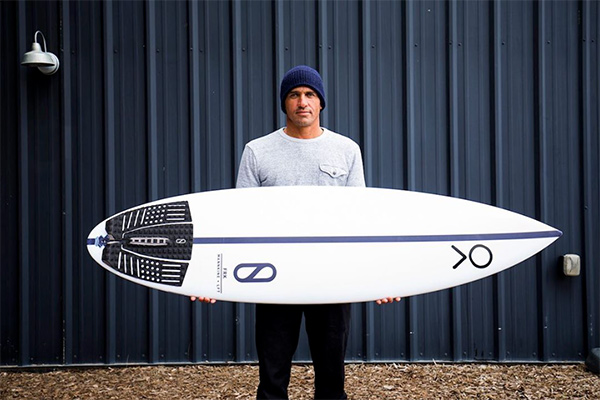
It has demonstrated the ability to injection mold, thermoform and foam the resulting resins to make sustainable products. The firm says the material is being used to make shoes, yoga mats, surfboards, and other sports and consumer products. It has also developed algae-based plastic filament for 3D printing and is targeting its new Bloom Stride grade of resin as an ingredient for conventional thermoplastic rubber (TPRs).
Algae, Hunt notes, represents a natural thermoplastic material to displace fossil fuel-based plastics in various consumer applications. He asserts that Bloom materials allow companies to innovate and create more eco-conscious products with measurable impacts.
Algix today operates a 70,000-square-foot, modern manufacturing facility in its headquarters city of Meridian, Miss., in the heart of catfish country, where it has access to plenty of green, algae-ridden lakes and ponds. Algix has grown the algae biomass supply chain globally, and has strategic partners harvesting and drying algae around the world that cleans air and water pollution. The firm has its own product distribution arm, Dongguan Bloom Trading Co., and has developed a customer network of more than 200 factories worldwide, Hunt says, including throughout Asia and in Europe.
Avrio rolls out eco-footwear
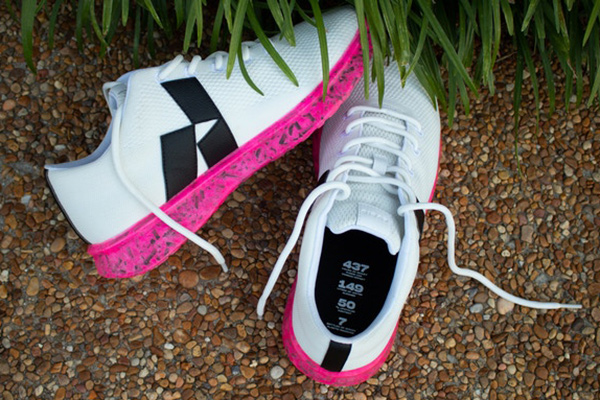
One of Algix’s newest partners is start-up brand Avrio Footwear, which just unveiled its first ultra-sustainable shoe combining Bloom Algae Foam, Oceanworks recycled ocean-bound plastics, an Oxi-Tex H2O2 antimicrobial coating, and Blumaka circular manufacturing technologies to create a comfortable, highly sustainable sneaker that also naturally protects the shoe against microbes such as bacteria, fungus, mold, mildew and viruses.
“We are collaborating with forward-thinking brands that want to raise awareness about algae and sustainable technologies,” Hunt notes, “by applying innovation, sustainability, and circularity to rethink how to design and manufacture shoes that reduce the environmental footprint compared to the status quo.”
Algix has rebranded its Bloom EVA resin as Bloom Rise, and is targeting it as an environmentally conscious, high-performance replacement for traditional, 100 percent petroleum-based EVAs. “Algae’s natural thermoplastic qualities allow Rise to meet, and in some cases exceed, the performance characteristics of conventional closed-cell flexible foams,” Hunt claims.
Promoting ‘measurable impact’
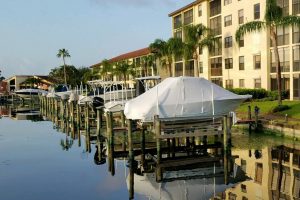
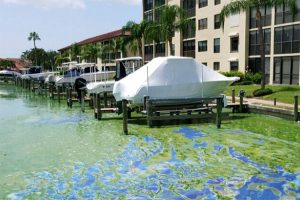
Hunt acknowledges that, while the algae technology is proven, the biggest challenge now is in raising awareness of the positive eco impact of end products such as shoes, yoga mats and consumer products. The firm has hired a pair of Nike veterans, and says that “more than 100 brands are now using our product, including adidas.”
Citing data from a third-party, peer-reviewed life-cycle analysis, Algix makes the following claims related to how much air and water are cleaned using just 1 kilogram of Bloom Rise masterbatch:
* 2,253 liters of fresh water are returned to the environment, after harvesting the algae from it; and
* 1,412 cubic meters of air are cleaned, since the algae sequesters carbon, removing it from the air and locking it away in a biomass.
Now, Hunt says, we want to share the impact of the Bloom story to more brands worldwide, and to “emotionally connect” consumers to the brand by promoting the measurable environmental impact that using Bloom in products can have.
Resources:
Algix: www.algix.com
Bloom: www.bloomtreadwell.com
Avrio: www.avriofootwear.com
The views, opinions and technical analyses presented here are those of the author or advertiser, and are not necessarily those of ULProspector.com or UL Solutions. The appearance of this content in the UL Prospector Knowledge Center does not constitute an endorsement by UL Solutions or its affiliates.
All content is subject to copyright and may not be reproduced without prior authorization from UL Solutions or the content author.
The content has been made available for informational and educational purposes only. While the editors of this site may verify the accuracy of its content from time to time, we assume no responsibility for errors made by the author, editorial staff or any other contributor.
UL Solutions does not make any representations or warranties with respect to the accuracy, applicability, fitness or completeness of the content. UL Solutions does not warrant the performance, effectiveness or applicability of sites listed or linked to in any content.



This is fantastic…
how can i get hold of a trial sample in Cape Town South Africa for trials in Injection Moulding.